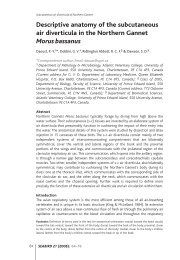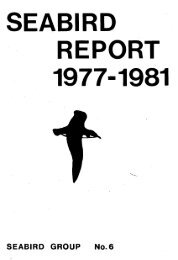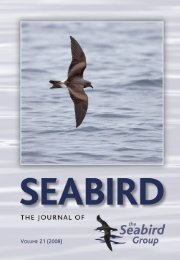Create successful ePaper yourself
Turn your PDF publications into a flip-book with our unique Google optimized e-Paper software.
166 I. LANGSETH ET AL. Atlantic <strong>Seabird</strong>s 3(4)<br />
<strong>The</strong> basal metabolic rate (BMR) is defined as the rate of energy<br />
transformation in an endothermic organis m in a rested, awakened, fasting and<br />
thermoneutral state (IUPS <strong>The</strong>rmal Commission 1987), and is considered as an<br />
obligatory part of the total energy expenditure. Allometric relationships between<br />
BMR and body mass (BM) reveal mass exponents of 0.60-0.82, depending on<br />
taxonomic level (Elgar & Harvey 1987; Bennet & Harvey 1987). This partially<br />
reflects the relationship between body surface and volume, which roughly<br />
calibrates with BM 0.67 . Heusner (1984) stated that when body mass changes<br />
while other properties that affect the metabolic rate (temperature, density, massspecific<br />
enthalpy, chemical composition, form) remain unchanged, energy<br />
turnover should calibrate approximately with BM 0.67 , also called a homomorphic<br />
variation. Considerable deviations are often noted from the allometric<br />
relationships and interspecific variation in BMR has been considered as an<br />
adaptation to environmental differences and ways of living (Bennet & Harvey<br />
1987). <strong>The</strong>re is also increasing evidence that even within single species BMR is<br />
a flexible parameter that changes with season, or with other external or internal<br />
factors (Daan et al. 1989; Piers ma et al. 1996). Intra-individual mass-exponents<br />
in excess of 1.0 have been found in birds (Daan et al. 1989; Deerenberg et al.<br />
1998). This indicates that change in body mass also may include a change in<br />
other properties that can alter metabolic intensity.<br />
<strong>The</strong> possible impact of an alteration in BMR on total energy<br />
expenditure is not clear. Some argue that since BMR represents the cost of<br />
keeping the metabolic machinery operative, the BMR-level should reflect the<br />
total capacity of this machinery. BMR and the maximal sustained metabolic rate<br />
should then be closely linked (Drent & Daan 1980; Daan et al. 1990; Hammond<br />
& Diamond 1997). In this case it would be advantageous to have a high BMR in<br />
periods with elevated energetic demands in order to be able to increase the total<br />
energy turnover, and a reduction in BMR would consequently reflect a reduced<br />
maximal metabolic capacity. Other studies have failed to find any relationships<br />
between BMR and the maximal metabolic rate within a species (Hayes et al.<br />
1992; Konarzewski & Diamond 1994; Meerlo et al. 1997). This would argue in<br />
favour of a possible benefit of a decrease in BMR during energy demanding<br />
periods, since a reduction in BMR will enable more of the available energy to be<br />
allocated into other activities, such as reproduction (Gadgil & Bossert 1970).<br />
Black-legged Kittiwakes Rissa tridactyla lose mass during chick<br />
rearing (Moe et al. 2001), a period in which both their activity level and total<br />
energy expenditure increases (Fyhn et al. 2001). <strong>The</strong> aim of the present study<br />
was to investigate whether a change in body mass of breeding female Blacklegged<br />
Kittiwakes corresponds with changes in their BMR and to discuss what<br />
possible impact this would have on their energy balance.








